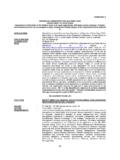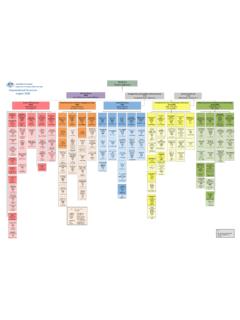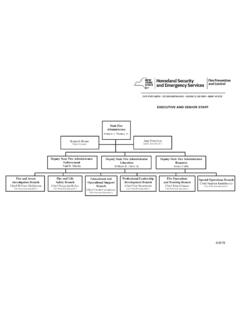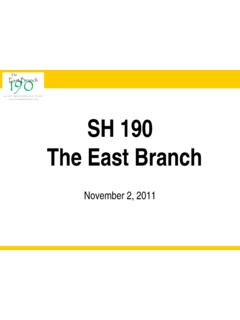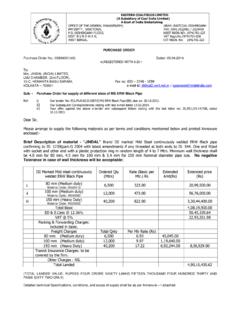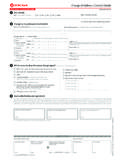Transcription of THE FAO BLUE GROWTH INITIATIVE: STRATEGY FOR THE ...
1 FAO fisheries and aquaculture Circular FIAA/C1161 (En) ISSN 2070-6065 THE FAO BLUE GROWTH initiative : STRATEGY FOR THE development OF fisheries AND aquaculture IN EASTERN AFRICA FAO fisheries and aquaculture Circular No. 1161 FIAA/C1161 (En)THE FAO BLUE GROWTH initiative : STRATEGY FOR THE development OF fisheries AND aquaculture IN EASTERN AFRICA by Devin Bartley Consultant fisheries and aquaculture Department, FAO Roma, Italy Ana Menezes aquaculture Officer fisheries and aquaculture Department, FAO Roma, Italy Rebecca Metzner Senior Fishery Officer fisheries and aquaculture Department, FAO Roma, Italy and Yaw Ansah Junior Professional (Fishery and aquaculture ) Subregional Office for Eastern Africa, SFE Addis Ababa, Ethiopia FOOD AND AGRICULTURE ORGANIZATION OF THE UNITED NATIONS Rome, 2018 The designations employed and the presentation of material in this information product do not imply the expression of any opinion whatsoever on the part of the Food and Agriculture Organization of the United Nations (FAO)
2 Concerning the legal or development status of any country, territory, city or area or of its authorities, or concerning the delimitation of its frontiers or boundaries. The mention of specific companies or products of manufacturers, whether or not these have been patented, does not imply that these have been endorsed or recommended by FAO in preference to others of a similar nature that are not mentioned. The views expressed in this information product are those of the author(s) and do not necessarily reflect the views or policies of FAO. ISBN 978-92-5-130261-3 FAO, 2018 FAO encourages the use, reproduction and dissemination of material in this information product. Except where otherwise indicated, material may be copied, downloaded and printed for private study, research and teaching purposes, or for use in non-commercial products or services, provided that appropriate acknowledgement of FAO as the source and copyright holder is given and that FAO s endorsement of users views, products or services is not implied in any way.
3 All requests for translation and adaptation rights, and for resale and other commercial use rights should be made via or addressed to FAO information products are available on the FAO website ( ) and can be purchased through This publication has been printed using selected products and processes so as to ensure minimal environmental impact and to promote sustainable forest management. iii PREPARATION OF THIS DOCUMENT The preparation of this document benefitted greatly from the funding provided through the FAO Multipartner Programme Support Mechanism (FMM) to the Blue GROWTH initiative (BGI), in Support of Food Nutrition Security, Poverty Alleviation and Healthy Oceans (FMM/GLO/112/MUL Baby 04). This document was derived from the Consultative Meeting on the Blue GROWTH STRATEGY for the development of the fisheries and aquaculture Sectors in Eastern Africa , which was convened in Addis Ababa, Ethiopia, 29 31 March 2017.
4 An extensive background paper was developed that formed the basis for discussions at this meeting. ACKNOWLEDGEMENTS The contributions of the participants to the Stakeholder Consultative meeting, and staff of the FAO Sub-Regional Office for Eastern Africa and the fisheries and aquaculture Department in Rome are gratefully acknowledged. The authors would like particularly commend the extensive reviews and inputs received from Ms Nancy Gitonga, Ms Betty Nyandat and Ms Betty Nyonje. Special thanks are to be expressed to Ms Jacqueline Alder (FISHCODE Manager, FIDF) and to Mr Malcolm Beveridge) (Acting Branch Head, FIAA) for their extensive technical inputs during the preparation of the background document as well as their support to the planning and implementations of the stakeholder consultative meeting in Addis Ababa.
5 Iv FAO. 2018. The FAO Blue GROWTH initiative : STRATEGY for the development of fisheries and aquaculture in Eastern Africa, by Ana Menezes, Devin Bartley, Rebecca Metzner and Yaw Ansah. FAO fisheries and aquaculture Circular No. 1161, Rome, Italy. ABSTRACT As part of FAO s Blue GROWTH initiative (BGI) the FAO Member Countries of the Eastern Africa Sub-Region met to agree on a STRATEGY for the development of fisheries and aquaculture within the Blue GROWTH initiative in Eastern Africa (BGI STRATEGY ). The BGI is an FAO flagship initiative that aims at supporting more productive, responsible and sustainable fisheries and aquaculture sectors by improving the governance and management of the aquatic ecosystems, by conserving biodiversity and habitats, and by empowering communities. The BGI is the sustainable GROWTH and development emanating from economic activities in the oceans, wetlands and coastal zones that minimize environmental degradation, biodiversity loss and unsustainable use of living aquatic resources, and maximize economic and social benefits.
6 The STRATEGY includes 11 over-arching development objectives that are common to fisheries and aquaculture in marine and freshwater environments: 1. To enhance governance and management of fishery resources and aquatic ecosystems 2. To improve global and intra and inter trade and marketing of fish and fisheries products 3. To enhance production efficiency with reduced impacts on the environment 4. To create an enabling environment for the private sector and social support 5. To facilitate people involved in fisheries and aquaculture to utilize resources and to also play an active role in protecting and safeguarding these resources for the benefit of future generations 6. To conserve aquatic biodiversity and critical habitat 7. To empower communities and make them resilient to natural and human induced impacts 8. To enhance information and knowledge sharing, dissemination, collection and management 9.
7 To develop Intra-regional synergies in management of transboundary resources and transfer of technology 10. To strengthen intra and inter regional collaboration 11. To enhance research and innovation In addition the STRATEGY contains specific objectives and actions to achieve them for inland fisheries , marine fisheries and aquaculture . The actions were chosen to also address the four streams of the BGI: i) capture fisheries ; ii) aquaculture ; iii) ecosystem services contributing to livelihoods; and iv) trade, markets, post-harvest and social support. The actions further embrace the principles of the Green Economy and will lead to Blue Production, Blue Communities and Blue Fora. Implementing a BG STRATEGY in Eastern Africa will require partnerships, collaboration with a variety of organizations. No one group has the full suite of needed knowledge and expertise in fisheries , aquaculture , trade, community development and maintenance of biodiversity and ecosystem services to implement the BG STRATEGY alone.
8 Partners will include fisherfolk, national development agencies, governing bodies, regional economic commissions, regional fishery bodies, regional trade portals, intergovernmental organizations, non-governmental organizations and international development banks. Sub-regional coordination and communication in awareness raising, project development , out-reach, extension, and engaging the private sector will be essential for the implementation of the BG STRATEGY . Policy and decision makers are encouraged to establish mechanisms to adapt the Blue GROWTH STRATEGY to the national priorities and opportunities. v CONTENTS Page PREPARATION OF THIS DOCUMENT iii ABSTRACT iv ABBREVIATIONS AND ACRONYMS vi 1. INTRODUCTION 1 2. THE BG STRATEGY IN EASTERN AFRICA 5 Blue GROWTH STRATEGY for Inland Capture fisheries in Eastern Africa 6 Blue GROWTH STRATEGY for Marine Capture fisheries in Eastern Africa 11 Blue GROWTH STRATEGY for aquaculture in Eastern Africa 15 3.
9 PARTNERS IN BLUE GROWTH 22 4. THE WAY FORWARD 24 APPENDIX 25 FIGURES Figure 1. Human population GROWTH in Easter Africa 2 Figure 2. Gross National Income in Eastern Africa (USD) 3 Figure 3. Fish production in Eastern Africa 4 Figure 4. Fishery production in Eastern Africa by country 4 Figure 5a. Fishery production in Eastern Africa 5 Figure 5b. Per capita fish supply in Eastern Africa based on supply of crustaceans demersal fish, freshwater fish, marine fish and pelagic fish; supply of molluscs was negligible 5 TABLES Table 1. Actions for Blue GROWTH in inland fisheries 7 Table 2. Actions for Blue GROWTH in Marine fisheries 12 Table 3. Actions for Blue GROWTH in aquaculture 16 Table 4. Key partners, stakeholders and sectors in implementing the BG STRATEGY in Eastern Africa 22 vi ABBREVIATIONS AND ACRONYMS ADB African development Bank AEM African Eco-labelling mechanism ARSO African Standardization Organisation AU African Union AU-IBAR Interafrican Bureau for Animal Resources of the African Union BG Blue GROWTH BGI Blue GROWTH initiative CAADP Comprehensive Africa Agriculture development Programme CCRFA Code of Conduct for Responsible fisheries and aquaculture COFI Committee on fisheries COMESA Common Market for Eastern and Southern Africa CORDIO Coastal Oceans Research and development CPF Country Programme Frameworks CPUE Overfishing and decreased catch per unit effort CSO Community Service Organizations EA ecosystem approach
10 EAC East African Community EDF Environmental Defense Fund EFMIS Electronic Fish Market Information Service EU European Union FAO Food and Agriculture Organization FIPs fishery improvement projects GEF Global Environment Facility GIZ German Society for International Cooperation GNI Gross National Income ICN International Conference on Nutrition ICZM integrated coastal zone management IDB Islamic development Bank IFAD International Fund for Agricultural development IGAD Intergovernmental Authority on development INFOPECHE Intergovernmental Organization for Marketing Information and Cooperation Service for Fishery Products in Africa INFOSA Marketing Information and Technical Advisory Services for the fisheries Industry IGAD Intergovernmental Authority on development IGO Inter-governmental Organisation ILRI International Livestock Research Institute INGO International Non-Governmental Organization IOC Indian Ocean Commission IORA Indian Ocean Rim Association IOTC Indian Ocean Tuna Commission IUCN International Union for Conservation of Nature IUU illegal.










